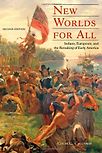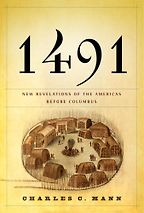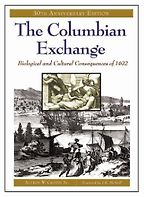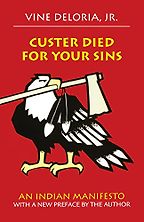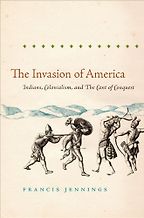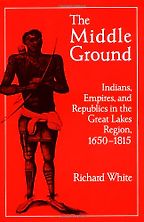I want to start out on solid footing by establishing how I should refer to the subjects of our discussion this Thanksgiving.
There are a variety of terms – some people prefer indigenous, some people prefer Native American, and some people prefer American Indian. They are all collective terms and they are all imperfect terms – some people would say they’re all a little offensive – but I’ve always used them interchangeably. I work in a Native American Studies programme, most of my colleagues are natives and they use these terms interchangeably. So I’m not sure if there is one right answer.
Even in an age of scepticism and multiculturalism, four-year-olds, like my son, already can recount the hallowed story of how Pilgrims from the Mayflower were able to thrive in America by learning the ways of the land from friendly indigenous people. My aim is to demythologise that simple picture by discussing your five books, but before we dive into them, please demythologise the roots of Thanksgiving itself for us.
The account of Thanksgiving that we have is Edward Winslow’s account [written in 1622]. It is quite brief but around it has sprung up stories and traditions and, if you like, myths. But the notion of early European colonists depending on Native Americans for food, shelter and even survival is not a myth. It happened quite frequently and is an important part of the story for our society. For a long time European colonists were dependent on Indian people as Indian people become increasingly dependent on Europeans and their imports. There was a long era of European colonists and native people living alongside one another while exchanging technology, exchanging information and exchanging ideas.
Let’s begin before the Niña, the Pinta, and the Santa María, let alone the Mayflower, arrived in the Americas. What would we learn about human civilisation in the Americas prior to Columbus’s landing by reading Charles Mann’s 1491.
Charles Mann’s 1491 is subtitled “New Revelations of the Americas Before Columbus”. He pulls together a lot of the new research over the last generation in one place and provides the reader with a helicopter overview of the American hemisphere on the eve of contact. He goes into a great deal of detail and from that a reader gets a very different picture, not just of the Americas in 1491, but also the whole world in 1491. Mann shows that the Americas were not just an empty world waiting for Europeans to arrive and create a greater American nation – but a place where civilisation had risen and fallen, where there were great cities that contained probably as much population as Europe at the time, if not more, where corn agriculture had transformed large areas of the continent, and where Indian people had created changes in the land that left their imprint on the environment. The book provides a huge hemispheric overview.
Mann’s revisionism is not simply based on the same centuries-old evidence from a different theoretical perspective. He draws from researchers who are using new scientific techniques to uncover evidence, which is forcing historians to reconsider long-settled assumptions about pre-Columbian American life. Correct?
People are working in Native American history in all kinds of areas. There are new discoveries, it seems, every year in archaeology. Increasingly, native scholars are making their voices heard and scholars who are not native are much more receptive to that. Anthropologists, in the last generation or so, more often work with historical sources and historians are drawing on the work of these anthropologists so there’s a whole new range of inquiry triggering new understandings of the role of native people in how America develops.
One area where that is particularly true is the whole issue of population. One of the larger changes in understanding has to do with the size of the population before contact and the extent of the population collapse after contact. Back in the old days, people would throw about estimates of pre-Columbian population north of Mexico as maybe a million. Now, as a result of the work of experts in demography and epidemiology, we have a much greater understanding of population dynamics. When Europeans were in an area doing head counts, more often than not they were recording the number of survivors of epidemics like smallpox, influenza, measles, and other crowd-killing diseases that came to America with Europeans but were not present in America beforehand. The cumulative effect of these epidemics on the native population throughout the hemisphere was absolute devastation. As one scholar described it, it was one of the greatest biological disasters in human history.
Some people argue about the numbers; some people question the calculations. But I think the important point is the revisions of population estimates, wherever they land, leave us with a different impression of pre-contact America. It was not an empty or sparsely inhabited continent but a world full of Indians. It was a place where much of the world’s population lived and the impact of contact played out through epidemic disease shifted that dramatically. You can’t understand the subsequent history of America without understanding that population collapse.
This seems an apt time to consider the consequences of European arrival on the existing population of the Americas. Tell us about the core argument of Alfred Crosby’s Columbian Exchange.
Alfred Crosby’s Columbian Exchange was published in 1972. If we read it today, especially in the wake of reading something like 1491, it might seem quite sparse, because since then scholars have done a huge amount of work in fleshing out this idea.
I think titles are important and I think this title, Columbian Exchange, is hugely important because it puts early colonial history into a broader context, so that the European invasion of America is not seen as a one-way street with humans simply crossing the Atlantic and landing in America. It’s two continents coming into contact and so opening up transoceanic exchange of people and plants and animals and disease. Crosby was the first scholar to point to the impact of epidemic diseases. Much more intensive and sophisticated work has been done since, but Crosby’s work was crucial, and there’s nothing more important to understanding that early history of America.
Is the communication of communicable diseases what led to European dominance over the hemisphere?
It’s not the only factor. As Jared Diamond’s book title says: Guns, Germs and Steel. There are a number of issues to consider but I think disease is important to understanding the invasion and colonisation of the Americas and even the subsequent expansion of the United States nation westward. Whenever we consider how native peoples are coping with, responding to, and adjusting to the presence of Europeans and the expanding power of the United States, we should recall the impact of disease on the population. Disease undermines Native Americans’ capacity for resistance at the very time when they need the utmost capacity. It upsets the balances of power and relations between native peoples so I think it certainly has to be high on the list, if not at the top of the list, in understanding how things play out in this continent.
Let’s take a detour from straight history to discuss Custer Died for Your Sins: An Indian Manifesto from 1969 by Vine Deloria Jr. What is this book about and why is it so important to demythologising the story of Indians in America?
Custer Died for Your Sins is not primarily about early American history – it’s a groundbreaking collection of essays in which Vine Deloria, a Lakota writer, scholar and activist, takes a series of pot shots at federal Indian policies and Anglo academics who made their careers as so-called “Indian experts”. Vine Deloria, who died in 2005, was in many ways the most influential Native American intellectual for the 20th century.
Get the weekly Five Books newsletter
What this collection did was alter the way we think about and discuss Native American history. His writings in Custer Died for Your Sins put non-Indians on the defensive. He made us think twice about the kind of work that we do and how we should do it. There’s also a powerful articulation of tribal sovereignty and self-determination. He puts Indian concerns, Indian rights, the continuing injustices that native people suffer and the continuing hypocrisies in American society about Indians, in plain view at a time when American society, by and large, still misunderstands Native American experiences, frustrations and aspirations. It’s a reminder that even though we’re working on the 17th or 18th century, what we do has an impact on contemporary native communities. Native people have clear views on their history and we’d better consider those views if we want our work to be relevant.
The word manifesto sounds awfully serious but this book seems quite funny.
There are certain passages that are quite funny. He makes fun of anthropologists who arrive in Indian country and take notes and have an assistant with them and leave to write up their findings and become recognised as experts on the subject, when the people in the community that they’ve visited, if they ever read those things, would often think: “That doesn’t sound like us, this is ludicrous.” A scenario like that continues to be a caution in the back of the minds of people who are trying to work responsibly in Native American history. So it’s not only funny, we can recognise that what he’s talking about is partially true. Non-native people working on Native American history don’t want to be like those people Vine Deloria made fun of. So I think, even though there’s humour in all of Vine Deloria’s writing, some of it quite rapier-like, there are also important points behind it. That’s why I wanted to include Custer Died for Your Sins on this list.
The author of your next book recasts the arrival of Europeans in the hemisphere as an incursion. Please tell us about The Invasion of America: Indians, Colonialism and the Cant of Conquest.
Again I think titles are important. I actually teach a course here at Dartmouth called “The Invasion of America”. It’s one of those titles that makes people stop and think: “Invasion of America, when did that happen?”
Francis Jennings was hard hitting. Some people would say this book is polemical. He exposes the mythologies of early contact. He focuses on New England because it is the locus of myths about American Indians and early contacts. Instead of dwelling on Thanksgiving and all the good feelings associated with that, Jennings accuses Puritans of dispossessing native people through manipulation of deeds, assaulting native culture and committing genocide like in the Pequot War. He also accuses them of distorting the historical record to justify their actions.
It’s a bit much for many people and many of his assertions have since been challenged and modified by subsequent generations of scholars, who took up his challenge to pore over records that had previously gone unexamined. But I think The Invasion of America triggered a new level of debate among historians and anthropologists about the early history of America and helped prompt a new generation of scholarship about American Indian history.
Were Puritans imperialist, as Jennings argues?
If you look at history, you can find evidence of everything. You can find evidence of people who were vicious, manipulative and genocidal, and you can find people who dealt equitably and even-handedly with natives. There are examples where Puritans and Indian people got along – they had to get along because they both needed each other. So you get cautious coexistence across gulfs of culture. But that shifts as the power dynamics shift. As the English presence in New England became more established, they were less reliant on Native American people and less respectful of them. Puritans can be seen as part of colonialism in North America. Looking at their actions in the Pequot War and King Philip’s War, there’s a lot of evidence to support the perspective that Francis Jennings puts forward.
How friendly were the Native Americans who met the Puritans? That sounds like an awful question, but I just want your help in demythologising the story of Squanto shaking hands with Puritans.
The word friendly is a little sketchy. We have to understand those first contacts in context. If we use the term “friendly” it gives this impression of a naive or simple people welcoming the English with open arms. When Squanto meets the Puritans, Squanto has already been to Europe, he’s been kidnapped, taken to Spain, and made his way back home where he found his people, the Patuxet people, essentially decimated by disease. So when the Puritans arrive, that area of New England is not a virgin wilderness – it’s a place that has already been ravaged by disease carried over on boats from England that came up the coast between 1616 and 1619. The impact of those diseases on that coast affected intertribal balances of power. If the Wampanoag people in Massachusetts suffered heavily from disease, other native powers further to the west suffered less so and so there’s a shifting going on in the balance of powers which makes the arrival of a new power, from across the Atlantic, something to be taken seriously. So it behoves the Wampanoag to embrace these people as allies.
Five Books interviews are expensive to produce. If you're enjoying this interview, please support us by donating a small amount.
Native societies on the east coast of North America have been dealing with other peoples for hundreds of years. Different Indian nations had their own foreign policies, their own sets of relationships, their own rituals for conducting trade, and their own protocols for establishing alliances. It’s important not to see these first contacts as Indian people reacting to English overtures alone. What you have is a multitribal, multinational world in which different Indian nations have their own agendas, their own experiences and their own sets of relations with other native people. Inject into that the presence of these new people. Different nations respond differently. Some incorporate the English into their diplomatic networks. This wasn’t a case of primitive Indians making naive gestures of friendliness.
Thank you for meeting such a poorly phrased question with such an illuminating answer. In your next selection, Richard White moves beyond the story of cultural conquest to discuss how Native Americans and Europeans came to coexist. Please tell us about the complex picture that White paints in The Middle Ground.
Richard White’s The Middle Ground shifts the focus away from the East Coast to the upper Great Lakes. The first part of the book, and I think the most important part, focuses not on the relationship between the English and Indians but on the relationship between the French and Indians. It’s very important to remember that the English were only one of a number of European nations that tried to establish colonial footholds and, in so doing, had to establish relationships with native people.
The French were early actors, particularly in Canada. They worked their way up the Saint Lawrence River and across the Great Lakes and down the Mississippi Valley toward New Orleans. But the Great Lakes area was the primary thrust of French colonialism – they were driven by the desire to harvest Indian furs and the missionary impulse to save Indian souls.
Richard White complicates understandings of Indian and white relations by looking at how Indians and Europeans – in a world already thrown upside down because of the impacts of disease, escalating warfare involving the fur trade and an arms race, as Indian people scrambled to get the guns they needed to survive – constructed a complex world that was new to all the participants.
Get the weekly Five Books newsletter
The middle ground was an area where Indian power was real, where Europeans who were ambitious about building empires, establishing trade or saving souls had to compromise and conciliate – not command. They had to adjust to doing business in Indian country in a world where kinship and fluctuating tribal alliances and multiple tribal agendas dictated life. It was an area of cautious coexistence, cultural convergence and alliances built on mutual need.
What do we learn about American culture through Richard White’s story of accommodation between the Algonquin and the French?
The Middle Ground is important because it helps destroy the notion that American history began in the east with the arrival of the English and spread westward. It’s far more accurate to look at North America as a mosaic or even kaleidoscope of different Indian peoples. So, for 20 years now, the Middle Ground has been part of the lexicon of Native American history, and a whole generation of younger scholars coming through looked at different areas of the country, tested White’s hypothesis and considered how European colonists conciliated with Indian power.
And finally, you wanted to slip in a footnote: That there is no better reading for Thanksgiving than Everything You Know about Indians Is Wrong by Paul Chaat Smith. What is the most important thing that we should realise is wrong about our perceptions of indigenous Americans?
From my perspective, as a historian of early America, the most important thing to realise is that the English did not arrive on the edge of a continent that was essentially empty. We cannot fully understand what happens after that first Thanksgiving without better understanding what had happened in the thousands of years leading up to that moment. That first Thanksgiving shouldn’t be seen just as something that occurred on the western edge of European history but rather as something that happened at the northeastern edge of an American Indian world, which stretched throughout the continent.
Interview by Eve Gerber
November 24, 2011. Updated: November 27, 2022
Five Books aims to keep its book recommendations and interviews up to date. If you are the interviewee and would like to update your choice of books (or even just what you say about them) please email us at [email protected]

